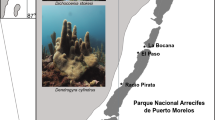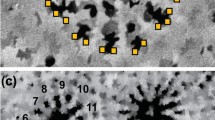Abstract
Calcification rates, normalized to skeletal mass, in the zooxanthellate Galaxea fascicularis and the azooxanthellate Dendrophyllia sp. were similar over the whole temperature range of 18–29 °C. Calcification was measured by Ca45 incorporation in corals that were naturally acclimated to the prevailing seawater temperature. In both species maximum calcification rate occurred at about 25 °C and calcification rates can be fitted to a Gaussian distribution with respect to temperature. The similarity in temperature dependence of the zooxanthellate and azooxanthellate coral suggests that temperature affects some fundamental process of calcification that is independent of light effects. It is shown that two different populations of Galaxea fascicularis have distinctly different ratios of tissue protein to skeletal mass per polyp. This indicates that tissue protein may not be suitable for normalizing calcification rates in individual coral polyps, both within and between species. Intra- and interspecific comparisons of calcification rates may be better made on the basis of skeletal mass when polyps are similar in size and shape.





Similar content being viewed by others
References
Abramovitch-Gottlib L, Katoshevski D, Vago R (2002) A computerized tank system for studying the effect of temperature on calcification of reef organisms. J Biochem Biophys Methods 50:245–252
Barnes DJ, Crossland CJ (1980) Diurnal and seasonal variations in the growth of a staghorn coral measured by time-lapse photography. Limnol Oceanogr 25:1113–1117
Bessat F, Buigues D (2001) Two centuries of variation in coral growth in a massive Porites coral from Moorea (French Polynesia): a response of ocean-atmosphere variability from south central Pacific. Palaeogeogr Palaeoclimatol Palaeoecol 175:381–392
Brown B, Le Tissier M, Howard LS, Charuchinda M, Jackson JA (1986) Asynchronous deposition of dense skeletal bands in Porites lutea. Mar Biol 93:83–89
Buddemeier RW, Kinzie RA (1976) Coral growth. Oceanogr Mar Biol Ann Rev 14:183–225
Buddemeier RW, Maragos JE, Knutson DW (1974) Radiographic studies of reef coral exoskeletons: rates and patterns of coral growth. J Exp Mar Biol Ecol 14:179–200
Chalker BE, Taylor DL (1978) Rhythmic variations in calcification and photosynthesis associated with the coral Acropora cervicornis (Lamark). Proc R Soc London B 201:179–189
Clausen CD, Roth AA (1975) Effect of temperature and temperature adaptation on calcification rate in the hermatypic coral Pocillopora damicornis. Mar Biol 33:93–100
Coles SL, Jokiel PL (1978) Synergistic effects of temperature, salinity and light on the hermatypic coral Montipora verrucosai. Mar Biol 49:187–195
Dodge RE, Brass GW (1984) Skeletal extension, density and calcification of the reef coral, Montastrea annularis: St. Croix, U.S. Virgin Islands. Bull Mar Sci 34:288–307
Gladfelter EH (1984) Skeletal development in Acropora cervicornis 3. A comparison of monthly rates of linear extension and calcium carbonate accretion measured over a year. Coral Reefs 3:51–57
Houck JE, Buddemeier RW, Smith SV, Jokiel PL (1977) The response of coral growth rate and skeletal strontium content to light intensity and water temperature. In: Third International Coral Reef Symposium, Miami, Rosenstiel School of Marine and Atmospheric Science, University of Miami, pp. 425–431
Howe SA, Marshall AT (2002) Temperature effects on calcification rate and skeletal deposition in the temperate coral, Plesiastrea versipora (Lamark). J Exp Mar Biol Ecol 275:63–81
Ip YK, Lim ALL, Lim RWL (1991) Some properties of calcium-activated adenosine triphosphatase from the hermatypic coral Galaxea fascicularis. Mar Biol 1991:191–197
Isa Y, Ikehara N, Yamazato K (1980) Evidence for the occurrence of Ca2+-dependent adenosine triphosphatase in a hermatypic coral, Acropora hebes (Dana). Sesoko Mar Sci Lab Tech Rep 7:19–25
Jacques TG, Marshall N, Pilson MEQ (1983) Experimental ecology of the temperate scleractinian coral Astrangia danae. II. Effect of temperature, light intensity and symbiosis with zooxanthellae on metabolic rate and calcification. Mar Biol 76:135–148
Jokiel PL, Coles SL (1977) Effects of temperature on the mortality and growth of Hawaiian reef corals. Mar Biol 43:201–208
Kajiwara K, Nagai A, Ueno S, Yokochi H (1995) Examination of the effects of temperature, light intensity and zooxanthellae concentration on calcification and photosynthesis of scleractinian coral Acropora pulchra. Tokai Daigaku Kiyo Kaiyogakubo 40:95–103
Krishnaveni P, Chou LM, Ip YK (1989) Deposition of calcium (45Ca2+) in the coral Galaxea fascicularis. Comp Biochem Physiol 94A:509–513
Lough JM, Barnes DJ (1990) Possible relationships between environmental variables and skeletal density in a coral colony from the central Great Barrier Reef. J Exp Mar Biol Ecol 134:221–241
Lough JM, Barnes DJ (2000) Environmental controls on growth of the massive coral Porites. J Exp Mar Biol Ecol 245:225–243
Loya Y (1985) Seasonal changes in growth rate of a Red Sea coral population. In:Fifth International Coral Reef Congress, Tahiti, pp. 187–191
Marsh JA (1970) Primary productivity of reef-building calcareous red algae. Ecology 51:255–263
Marshall AT (1996a) Calcification in hermatypic and ahermatypic corals. Science 271:637–639
Marshall AT (1996b) Calcification rates in corals. Science 274:117–118
Marshall AT, Wright A (1998) Coral calcification: autoradiography of a scleractinian coral Galaxea fascicularis after incubation in 45Ca and 14C. Coral Reefs 17:37–47
Miller MW (1995) Growth of a temperate coral: effects of temperature, light, depth, and heterotrophy. Mar Ecol Prog Ser 122:217–225
Peterson GL (1977) A simplification of the protein assay method of Lowry et al. which is more generally applicable. Anal Biochem 83:346–356
Rinkevich B, Loya Y (1983) Short-term fate of photosynthetic products in a hermatypic coral. J Exp Mar Biol Ecol 73:175–184
Tambutte E, Allemand D, Mueller E, Jaubert J (1996) A compartmental approach to the mechanism of calcification in hermatypic corals. J Exp Biol 199:1029–1041
Veron JEN (1995). Corals in space and time: the biogeography and evolution of the scleractinia. UNSW, Sydney
Yap HT, Gomez ED (1984) Growth of Acropora pulchra 2. Responses of natural and transplanted colonies to temperature and day length. Mar Biol 81:209–215
Acknowledgements
This work was carried out during the tenure of grants to A.T.M. from the Australian Research Council and under collecting permits to A.T.M. issued by the Great Barrier Reef Marine Parks Authority. We are grateful to R. Forbes (Heron Island research Station) and R. Berkelmans (Australian Institute of Marine Science) for provision of, and permission to use, temperature data. We are indebted to J.M. Lough (Australian Institute of Marine Science) for kindly providing us with the analysis of historical sea temperatures.
Author information
Authors and Affiliations
Corresponding author
Additional information
Communicated by Topic Editor C. Barnes
Rights and permissions
About this article
Cite this article
Marshall, A., Clode, P. Calcification rate and the effect of temperature in a zooxanthellate and an azooxanthellate scleractinian reef coral. Coral Reefs 23, 218–224 (2004). https://doi.org/10.1007/s00338-004-0369-y
Received:
Accepted:
Published:
Issue Date:
DOI: https://doi.org/10.1007/s00338-004-0369-y




